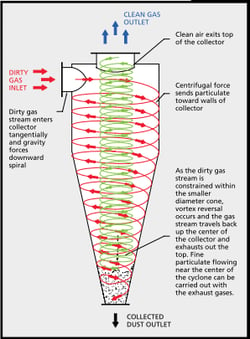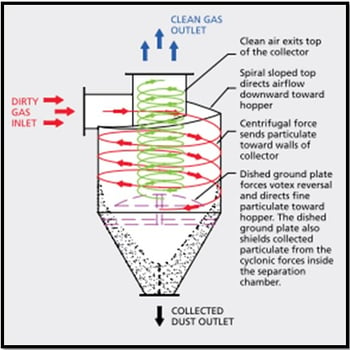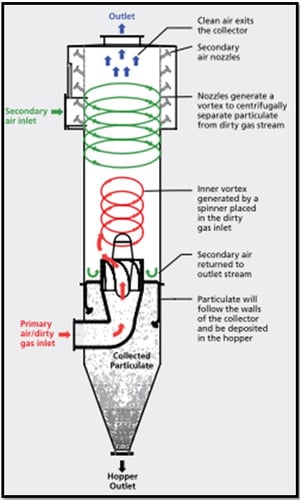Aerodyne manufactures two different types of cyclones - the GPC (Ground Plate Cyclone) and the SplitStream Collector. These Aerodyne cyclones are not the traditional cyclones with which you are probably familiar. Both cyclones can be designed for vertical or horizontal installation; traditional cyclones can only be vertical. The Aerodyne GPC and SplitStream cyclones also provide high particulate removal efficiency. The following describes the different cyclones that are available along with their advantages and disadvantages.
Traditional Cyclone
The typical cyclone design consists of a tangential inlet and a long-tapered body. Centrifugal forces force particulate out toward the walls, and gravitational forces direct the dirty gas stream downward through the narrowing body. As the gas stream becomes constrained in the narrow end of the cyclone body, a phenomenon known as “vortex-reversal’’ occurs in which a secondary inner-vortex is generated and moves upward through the center of the primary vortex where it is exhausted from the collector. Dust near the walls fall into the cyclone hopper and out of the airstream. The traditional cyclone must be vertical in design to operate effectively.
Vortex-reversal is one of the primary causes for inefficiencies in cyclonic dust collectors. As the inner vortex travels up through the cyclone, it takes with it any fine dust particulates that did not have the inertia to be forced tight to the collector walls.
Another issue that can develop with traditional cyclones is that an integral hopper could have dust re-entrainment into the clean airstream. Oftentimes, traditional cyclones will install a dust trap to prevent re-entrainment. The dust trap is located below the cyclone hopper and is designed to minimize particulate re-entrainment. If you’ve seen a cyclone with what looks like a pocket underneath it, it has a dust trap.
Aerodyne GPC Cyclone
The GPC cyclone uses a combination of a sloped spiral inlet and fixed ground plate to provide several distinct advantages over the traditional cyclone dust collector described above.
First, a spiral inlet directs the dirty gas stream toward the ground plate and hopper of the collector. This efficiently begins the centrifugal motion of the air without any dead spots. The fixed ground plate, utilized by the GPC removes the requirement of a long-tapered hopper. The ground plate provides the vortex-reversal, rather than the geometry of the tapered hopper in traditional cyclones.
As the dirty gas stream strikes the convex ground plate; fine particulate, which has not completely made it to the collector walls, is deflected into the hopper. The ground plate also shields collected particulate from the clean air, acting as a barrier between the separation chamber and collection hopper; Therefore, no separate dust trap is required.
The GPC design allows it to be much smaller than traditional cyclones and includes 6 sizes under 8ft3 per NFPA 654. A GPC cyclone is usually less than half the height of a traditional cyclone. The ground plate also removes the requirement of gravity, so it can be designed for a horizontal installation, with virtually no effect on collection efficiency. The horizontal GPC is around 1/3 of the height of a traditional. The removal efficiency is high (99% of 20 micron particulate*).
* spherical dust, specific gravity of 1
Aerodyne SplitStream Collector
The Aerodyne SplitStream Collector uses two airstreams to remove particulate in the air. The primary air stream enters the cyclone and proceeds through a mechanical spinner. The spinner imparts centrifugal motion into the airstream, thereby forcing dust particulate toward the cyclone walls. 
A secondary airflow enters the cyclone near the clean air exit. The secondary air proceeds through nozzles or vanes as it enters the cyclone. The secondary air then rotates around the outer edge of the cyclone, collecting particulates and delivering them into the hopper. The secondary air then reverses direction and joins the primary air and leaves the cyclone. Since the SplitStream Collector has no moving components, it is capable of handling a wide range of materials, while requiring minimal maintenance.
Particulate that is abrasive, fibrous, friable, sticky, or hygroscopic can be separated and collected for air pollution control or reclamation. The secondary air ensures that the dust doesn’t contact the walls. This minimizes wall abrasion for abrasive applications and areas. For particulate that is sticky, the secondary airflow keeps the dust from building up on the walls.
The SplitStream Collector has a very high removal efficiency of light, fluffy particulate that floats in the air. The secondary airstream also gives the option to heat up or cool down the process air and material. Removal efficiencies as high as 99% of 7- 10 micron dust range are normal*.
* as measured in limestone testing
To learn more about the different types of Dust Collection Methods, click here to download our free white paper. To request a brochure of the Aerodyne GPC Dust Collector, please visit www.DustCollectorHQ.com. For more information regarding the full line of Aerodyne industrial dust collection products and material airlock valves, call (440) 543-7400, toll-free at (800) 358-7546, or e-mail dc@dustcollectorhq.com.
To improve efficiency and safety, there is no substitute for an on-site inspection by an experienced expert. Click below to start with a free 20-minute phone consultation by clicking the button.

